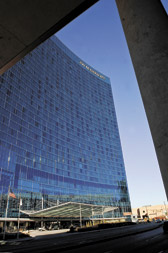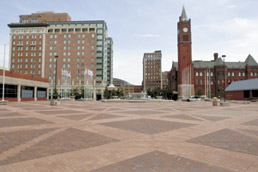Subscriber Benefit
As a subscriber you can listen to articles at work, in the car, or while you work out. Subscribe NowFears that the 1,600-room JW Marriott complex would flood the downtown lodging market and sink competing hotels didn’t hold water last year, but local hospitality officials and experts still are in no rush to launch a major new convention hotel.
In 2011, downtown hotel occupancy averaged 66.4 percent—a surprise increase from 65.3 percent the previous year, despite the opening of the three hotels in the Marriott complex in February. It pushed downtown inventory from about 5,500 rooms to 7,100 rooms, a gain of nearly 30 percent.
“I think everybody was worried with the JW Marriott that we would go through a period of too much inventory,” said John Livengood, president of the Indiana Hotel & Lodging Association. “It hasn’t been as bad as people thought it would be.”
Even with its expanded capacity, downtown’s hotel market is seen by some as still too small to attract the largest convention and tourism events. But hospitality bigwigs believe any talk of further bolstering the market is premature.
“For the vast majority of convention business we have in Indianapolis, the package [of rooms] we have currently works fine,” said Leonard Hoops, CEO of the Indianapolis Convention & Visitors Association.
 Some industry boosters have said downtown needs another hotel on the scale of the 1,005–room JW Marriott to augment the convention business. (IBJ file photo)
Some industry boosters have said downtown needs another hotel on the scale of the 1,005–room JW Marriott to augment the convention business. (IBJ file photo)“There are definitely convention groups that would want [another major downtown hotel], and we can’t book them without that,” Hoops said. “But there’s not enough demand in my opinion to warrant having too much inventory during other times in the year.”
Hoops, who took his post in 2011, would like to see downtown occupancy rates consistently post above 70 percent before a new hotel project begins in earnest. Over the last 25 years, rates typically have reached that level before construction of a major downtown hotel, after which they tended to temporarily drop to the mid-60s.
Although rates in 2012 might end up in the 70s, Hoops said, “it will be skewed from this year’s Super Bowl.”
Former ICVA CEO Don Welsh believed demand would be strong enough by 2015 to warrant another large hotel. Officials for the National Football League and many of the league’s sponsors said the city’s chances of landing another Super Bowl would improve if another hotel were added.
Such talk doesn’t play well with hoteliers outside of downtown. Occupancy in the 31,000-some rooms in hotels across the metropolitan area lagged behind at 57.5 percent in 2011—although still a nice jump from 54.8 percent in 2010.
Outlying hotels have typically counted on booking overflow guests when downtown hotels fill up for major events, said Jim Dora Jr., president and CEO of General Hotels Corp., which operates 10 hotels in Indiana.
With the addition of the JW Marriott complex creating more availability for patrons who want to stay downtown, suburban properties are in less demand for what would otherwise be “citywide” events.
“We have felt the softer market [outside downtown],” Dora said. “Until the economy picks up more steam, I think we’ll continue to feel that.”
That the downtown market improved occupancy after the new Marriott hotels opened is likely due mostly to the opening of the expanded Indiana Convention Center the month before.
Nearly 350,000 square feet of exhibit space was added to the convention center in January 2011, pushing it from 32nd-largest in the United States to the 16th spot. The facility, when combined with Lucas Oil Stadium, offers 1.2 million square feet of exhibit and meeting space.
The $275 million expansion helped the city retain some of its biggest convention clients—such as Gen Con Indy, which agreed to a five-year extension through 2020—and put it in the running for even larger events. And the JW Marriott complex—which includes the signature 1,005-room property, and two smaller, Marriott-branded hotels—provided a critical mass of centrally located rooms to help court conventions.
“The introduction of the expanded convention center and the JW Marriott were symbiotic events,” said Mark Eble, a hotel consultant and Midwest regional vice president for PKF Consulting. “They needed each other to happen.”
 Pan Am Plaza is considered a choice location for a new hotel due to its proximity to major sporting and convention venues, such as Lucas Oil Stadium. (IBJ file photo)
Pan Am Plaza is considered a choice location for a new hotel due to its proximity to major sporting and convention venues, such as Lucas Oil Stadium. (IBJ file photo)There is evidence that the expanded convention center, and perhaps even the Marriott complex itself, are driving more convention traffic to Indianapolis. In 2010, the ICVA worked with convention and meeting clients responsible for booking 491,000 hotel room nights in the city. In 2011, with the advent of the center expansion and Marriott complex, IVCA-assisted room nights grew to 644,000. The group is projecting 793,000 room nights for 2012.
Likewise, PKF Consulting is projecting greater occupancy rates for the Indianapolis area over the next several years: 58.2 percent in 2012, 58.6 percent in 2013, and 59.9 percent in 2014.
However, Eble of PFK agrees that moving forward on a new downtown convention hotel “is a little premature.”
“Down the road, I have no doubt that someone will decide that we should move to the next rung up,” he said.
The most obvious opportunity to develop a major hotel is Pan Am Plaza on the southeast corner of Capitol and Georgia streets. That places the property within spitting distance of the Indiana Convention Center, within a stone’s throw of Lucas Oil Stadium, and only a tee shot to Bankers Life Fieldhouse.
The prime parcel is now positioned for a major development due to a recent deal struck between locally based Kite Realty Group Trust—which owns the plaza and adjacent ice rinks—and New York-based Dali Associates LP, which owns the parking garage below the plaza.
Development of the site was stymied for years due to the separate ownerships. But they came together before Super Bowl XLVI this year to address safety concerns with the garage posed by structural deficiencies. The result was an agreement that will let Dali Associates maintain ownership of the garage but allow Kite to build a large-scale development on top of it.
Kite officials told IBJ in February that the firm was considering a wide array of projects for the parcel, including a high-rise hotel, restaurants, retail, office space and even residential.
Kite President Tom McGowan did not return calls from IBJ this month about Kite’s plans for the property.•
Please enable JavaScript to view this content.
